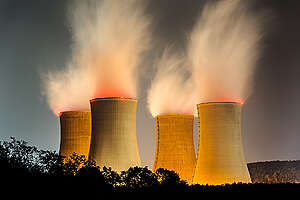
A new Greenpeace report has revealed that Australia is ranked 12th on the list of the top human-caused sulfur dioxide hotspots as tracked by NASA satellites.
Toxic sulfur dioxide pollution can cause childhood asthma, heart and lung disease, and even dementia and fertility problems.
Power stations burning coal and oil along with industrial smelters are responsible for two-thirds of human-caused toxic sulfur dioxide emissions tracked by NASA satellites.
Unlike other countries, there are no legislated limits on how much sulfur dioxide Australian coal power stations are allowed to emit.
Ageing coal-burning power stations in Australia are allowed to emit up to almost 12 times more sulfur dioxide than old power stations in China.
Industrial smelting and the burning of coal, oil and gas are the leading causes of toxic sulfur dioxide pollution in Australia.
The toxic sulfur dioxide plume in New South Wales potentially impacts 1.7 million people:

The toxic sulfur dioxide hotspot in Victoria potentially impacts 473,622 people:

This toxic sulfur dioxide plume in Queensland potentially impacts 21,696 people:

The above figures do not include the much greater number of people affected by secondary sulfur dioxide pollution.
What environment ministers need to do:
- Replace polluting coal-burning power stations with clean renewable energy within a decade
- Establish a national air pollution law that ensures all Australians are protected from the impacts of toxic air pollution
- Adopt clean air standards backed by leading health organisations
- Immediately adopt world-leading air pollution standards for coal-burning power stations to minimise harm to communities while coal burning power stations are replaced by clean renewable energy
Pollution findings from the report include:
- Australia is ranked 12th on the list of the top-emitting countries for human-caused sulphur dioxide as tracked by NASA satellites.
- Ageing coal-burning power stations in Australia are licensed to emit up to eight times more sulphur dioxide than old power stations in China.
- Industrial smelting and the burning of coal are the leading causes of toxic sulphur dioxide pollution in Australia.
- More than 51 per cent of total human-caused sulphur dioxide emissions in hotspot areas are emitted in regions of high coal consumption across the globe
- The biggest source of SO2 pollution in Australia is a complex of mining operations with lead and copper smelters in Mount Isa, Queensland. The other Australian hotspots are all located around coal-burning power stations such as Victoria’s Latrobe Valley, where a group of coal-fired power stations are located just 100km away from Melbourne.
- Lake Macquarie, NSW, where the Vales Point and Eraring coal-burning power stations are located, is also in the top 100 air pollution hotspots, followed by the Hunter Valley, which is home to the Liddell and Bayswater power stations.
The Victorian SO2 air pollution hotspot covers a population of over 470,000 people, and the NSW hotspot covers an area of over 1.7 million people, although the impacts from secondary pollution cover a far greater population.1
Health findings from the report include:
- Microscopic pollution from burning coal and oil can penetrate deep into organs and cells, harming every organ in the body
- Sulphur dioxide pollution reacts to form toxic particles that cause health problems from dementia and fertility problems to heart and lung disease.
- Toxic sulphur dioxide is one of the main contributors to human death and disease from air pollution across the planet.
- Australian coal-burning power stations are polluting at levels that would be illegal in China and most other parts of the world.
Unchecked air pollution causes over 4000 premature deaths in Australia each year, which is far more than the national road toll. 2
Air pollution is the price our communities pay for the Federal Government’s failure to stand up to big polluters. It’s time for state environment ministers to show leadership by championing health-based sulphur and nitrogen dioxide standards, strong pollution limits for industry and speeding up the switch to clean renewable energy.
Notes:
1 Based on report findings and Greenpeace Australia Pacific analysis of ABS data.


